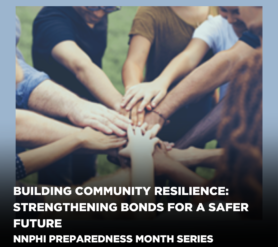National Preparedness Month Vol. 5: Building Community Resilience: Strengthening Bonds for a Safer Future
- By: National Network of Public Health Institutes and Jennifer Ventura
- Date
In a world where unexpected challenges can arise at any moment, the strength of a community often determines its ability to rebound and thrive. Learn about how the Federal Environmental Management Agency (FEMA) promotes awareness of building community resilience. September marks Environmental Preparedness Month, offering the perfect opportunity to focus on building community resilience. By working together and supporting one another, we can ensure that our neighborhoods are better equipped to face and recover from various emergencies.
Understanding Community Resilience
Community resilience refers to a community’s ability to effectively prepare for, respond to, and recover from nature-based events. Whether it’s a natural disaster, a health crisis, or any unexpected challenge, a resilient community is one that works collectively to minimize the impact and bounce back swiftly.
Ways to Foster Community Resilience
- Form Preparedness Groups: Collaborate with neighbors to form preparedness groups that focus on different aspects of readiness, such as emergency medical assistance, communication, and resource distribution within the community.
- Host Workshops and Training: Organize workshops and training sessions on topics like first aid, CPR, disaster response, and community emergency planning. These activities empower individuals with skills that can save lives during crises.
- Share Resources: Create a network for sharing resources during emergencies. Whether it’s providing shelter, food, or medical supplies, having a community-supported resource pool is invaluable.
- Engage with Vulnerable Populations: Consider the needs of vulnerable members of your community, such as the elderly, disabled, and those with special medical requirements. Develop plans to ensure their safety and well-being during emergencies.
- Communicate Effectively: Establish communication channels that facilitate the swift dissemination of information during emergencies. Social media groups, community apps, and text message chains have all proven to serve as effective tools when dealing with these sorts of disasters.
Benefits of a Resilient Community
- Faster Recovery: A resilient community can bounce back faster from disasters, reducing the overall disruption to daily life.
- Improved Well-Being: By collaborating and supporting one another, community members experience a greater sense of belonging, social support, and improved mental well-being.
- Efficient Resource Allocation: With a clear plan in place, resources can be allocated where they are needed most, ensuring a more efficient response to emergencies.
- Enhanced Problem-Solving: Resilient communities are adept at identifying challenges and collectively finding innovative solutions.
A Call to Action
As we observe Environmental Preparedness Month, let’s remember that building community resilience is a continuous effort that requires active participation from everyone. Take the initiative to engage with your neighbors, local organizations, and authorities to discuss and implement strategies that will strengthen your community’s ability to weather any nature-based disaster.
By fostering a culture of preparedness, collaboration, and support, we’re not only safeguarding our immediate future but also laying the foundation for a more resilient and thriving community for generations to come.
About the Author:
Jennifer Ventura is a Program Assistant on the Climate, Crisis, and Preparedness Portfolio at the National Network of Public Health Institutes (NNPHI). She received her bachelor’s degree in Public Health from George Mason University in 2021. With an interest in Public Health and working on a focus on environmental health, my passion lies in understanding the relationship between human well-being and the environment. Through academic pursuits and current work experiences, I’ve become interested in the critical role of promoting climate change awareness. Recognizing that a healthy environment is crucial for community health, I’m dedicated to advocating for policies and practices that foster sustainability and safeguard the planet for current and future generations.


 Subscribe To Our Communications
Subscribe To Our Communications